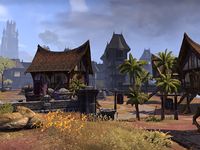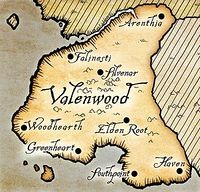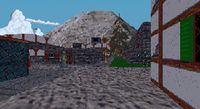Lore:Arenthia
| Arenthia | |
|---|---|
| Type | Settlement |
| Continent | Tamriel |
| Province | Valenwood |
| Region | Reaper's March (Northern Woods) |
| Demonym(s) | Arenthian[1] |
| Appears in | Arena, ESO |

Arenthia is one of the eight major cities in the province of Valenwood,[2] serving as the province's largest settlement in the borderlands of Reaper's March. Arenthia is the resulting amalgamation of various cultures that reside in, and have spread their influence throughout, the march. It is an important trade city that is nestled on the fork of both the Crescent River and the Strid River. It was named after the first King of the Wood Elves.[3]
Layout & Geography[edit]
The city-state of Arenthia is situated in the region of Reaper's March, near the point where the borders of Valenwood, Elsweyr, and Colovia, (Western Cyrodiil) meet. Arenthia's architecture and culture emphasize this cultural triumvirate. Arenthia's general area is known as the Northern Woods, which was at one point called the South Weald.[4] It is built on a fork where the Crescent River flows into the Strid River, which makes up a large portion of the northern provincial border and continues into Cyrodiil. Arenthia has two gates; the southern one leads into the rest of Reaper's March and Valenwood, while the northern bridge crosses the river, and enters the West Weald. The Strid River is surrounded by large hills and mounds. The outskirts consist of Ayleid ruins such as Senalana, and Colovian Forts, such as the town of Greenhill, and the well-known Moon Hunter Keep. Following the Crescent River will lead into the Falinesti Autumn Site, and the trading town of Rawl'kha. Rawl'kha's roads eventually led to Elsweyr and the city-state of Dune. Arenthia is neighbored by several settlements, including Thormar Keep to the southwest, the Imperial City to the northeast, and Elsweyr to the east, towards Dune.[2][5][6]
Arenthia is somewhat of a walled-off settlement, but the only defense comes from the natural mountains that cradle the city, and the Strid River's canyon. Arenthia is split into four districts. Outer Arenthia is surrounded by a traditional Imperial square, and various merchant stalls are set throughout the branching roads. Northwest of the square leads into the Strid bridge, while the southwest goes into Reaper's March. North of it is a small harbor, where many ships dock from the Strid River. Local guilds are found in west Arenthia. The Tower District is found in southern Arenthia, and it somewhat serves as a residential district. It is four buildings and a large tower that overlooks the city. The Temple District in the southeast contains a Temple to the Divines. It was abandoned following the Colovian's retreat from Reaper's March. It is said that Skooma Smugglers use the old Temple as their base of operations. Finally, there is the Residential District, found in east Arenthia. It contains several private homes and the Pious-Arenthi Inn, a rather large Imperial-style Inn that sits atop a mound that looks over the area.
History[edit]
Darloc Brae, known as The Beast of Anequina, led the Anequine Conquests in the Fifth Century of the First Era, when the Cat-Folk soldiers of the Golden Beast ruled the land from the Larsius River to the Strid, seizing the Bosmer city of Arenthia from Valenwood and adding it to his numerous military victories.[7][8]
In 1E 2714, the city, along with the rest of Valenwood, was conquered by the Second Empire, after centuries of unrelenting warfare along the border with Cyrodiil and a plague from Thras.[9] Although the province became occupied by the Imperial Legion, they continued to experienced resistance from some natives for several years.[10]
During the Second Empire, the city was re-founded, building a Colovian-style citadel over the older Bosmer settlement to serve as a center of trade between Colovia, Anequina and Valenwood. As the location of Arenthia was militarily strategic, the citadel was heavily fortified with tall walls and defensive towers, and two stone bridges were constructed to cross the western river at this point, which eased the troop movements between Cyrodiil, Valenwood and Elsweyr. From therefore, Arenthia consists of two well differentiated areas: the Imperial-style citadel, to the south, and the Khajiit and Bosmer shantytown, to the north and by the river. The Cathedral of the settlement also was built in this time. [11][12]
In 2E 580, Arenthia was incorporated into the First Aldmeri Dominion along with the rest of Camoran-controlled Valenwood after the Blacksap Rebellion was put down by the combined forces of Ayrenn and Aeradan Camoran.[13][14] During the Three Banners War in 2E 582, the city was invaded by Colovians under General Lavinia, leader of the Legion of the West Weald, and annexed to the Empire of Cyrodiil, only to discover that the cathedral, the principal symbol of Imperial occupation, had been abandoned during the early years of the Interregnum. Although nominally part of Valenwood, the eminent Khajiit presence in Arenthia elevated a Khajiit woman to leader of the Resistance against Colovian occupation. After the eventual defeat of General Lavinia with the help of the Vestige, a Clanmother began to rule the settlement in behalf of the Dominion, without discussing if the city should be part of Valenwood or Elsweyr. This situation remained until the eventual dissolution of the Dominion. After this, the majority, if not all, of the Imperials fled the city.[15]
In 2E 582, a circle of scholars from Arenthia was interested in forming relations with Reachfolk in exchange for knowledge. They opened an embassy in Markarth and worked with various clan chiefs.[16]
Again in 2E 830, the city was annexed by the Second Aldmeri Dominion after the intervention of Summerset in another Camoran civil war.[17] However, the use of the Numidium by Tiber Septim resulted in the conquest of both the entirely of Valenwood and the Summerset Isles in 2E 896, ending the Second Aldmeri Dominion control of the settlement, which was incorporated to the Third Empire.[18]
Since the beginning of the Third Era, Arenthia became part of the Province of Valenwood. Between 3E 249 and 3E 267, it was also reputedly the place where the Camoran Usurper first began his war of conquest, collecting a huge army of daedra and undead before first attacking Valenwood, then Hammerfell and High Rock.[19] For the rest of the Third Era, Arenthia remained an integral part of the Third Empire. During the Imperial Simulacrum in the late Third Era, the city-state of Arenthia was an active settlement, being ruled by King Coman. It had a rivalry with Silvenar.[20]
The Oblivion Crisis that ended the Third Era and weakened the Empire provided the opportunity for the Thalmor to seized the Summerset Isles. In 4E 29, a Thalmor-backed coup overthrew Valenwood's government, routing Imperial forces and their Bosmer supporters. Alinor and Valenwood then proclaimed a union, and a new Aldmeri Dominion was formed. The city fell into Aldmeri hands for the third time in history.[21] Though it was not under Imperial control in 4E 48, there was thought to still be some sentiment for the Empire by the inhabitants, as Attrebus Mede believed the city could be taken with a thousand men and the support of the locals.[22]:104
Culture[edit]
As of the Fourth Era, the city produces a vintage red wine, Arenthia Red.[23] Arenthian Brandy was produced in the Second Era.[24] Squeeze Boxes, hand-held musical reed instruments played by squeezing them in and out, were made in the city and popular with Colovian travelers by the mid-Second Era.[25]
Gallery[edit]
-
Arenthia circa 3E 389
Notes[edit]
- Arena was originally conceived as a fighting game featuring a tournament that took the player to each of Tamriel's cities to challenge different gladiatorial teams. According to a file from that stage of development left behind in the final game, Arenthia's gladiatorial team would have been called "the Huntsmen".[UOL 1]
References[edit]
- ^ Arenthian Brandy appearance and name in ESO
- ^ a b Map of Valenwood – The Elder Scrolls: Arena
- ^ Arenthia location text in Arena
- ^ Yours for the Taking! — Catonius Libo, Aide-de-Camp to General Lavinia Axius
- ^ Map of Elsweyr – The Elder Scrolls: Arena
- ^ Map of the Imperial Province – The Elder Scrolls: Arena
- ^ The description of Khaj Rawlith in ESO
- ^ Rislav The Righteous — Sinjin
- ^ Pocket Guide to the Empire, 3rd Edition: The Wilds Remain: Valenwood — Imperial Geographical Society, 3E 432
- ^ The Fall and Rise of Reman's Bluff — Praetor Aemilianus Lector
- ^ Cohort Briefing: Arenthia — Centurion Iunius Ocella
- ^ Arenthia's architecture and population in ESO
- ^ Welcome to New Aldmeri Irregulars — Aicantar of Shimmerene, Sapiarch of Indoctrination
- ^ The Rise of Cormount
- ^ Events of ESO
- ^ Bralthahawn's dialogue in ESO: Markarth
- ^ Pocket Guide to the Empire, 1st Edition: Aldmeri Dominion — Imperial Geographical Society, 2E 864
- ^ Brief History of the Empire v 1 — Stronach k'Thojj III
- ^ The Fall of the Usurper — Palaux Illthre
- ^ Events of Arena
- ^ The Great War — Legate Justianus Quintius
- ^ The Infernal City — Greg Keyes
- ^ Malborn's dialogue
- ^ The description of Arenthian Brandy in ESO
- ^ The description of Arenthian Squeeze Box in ESO
Note: The following references are considered to be unofficial sources. They are included to round off this article and may not be authoritative or conclusive.


